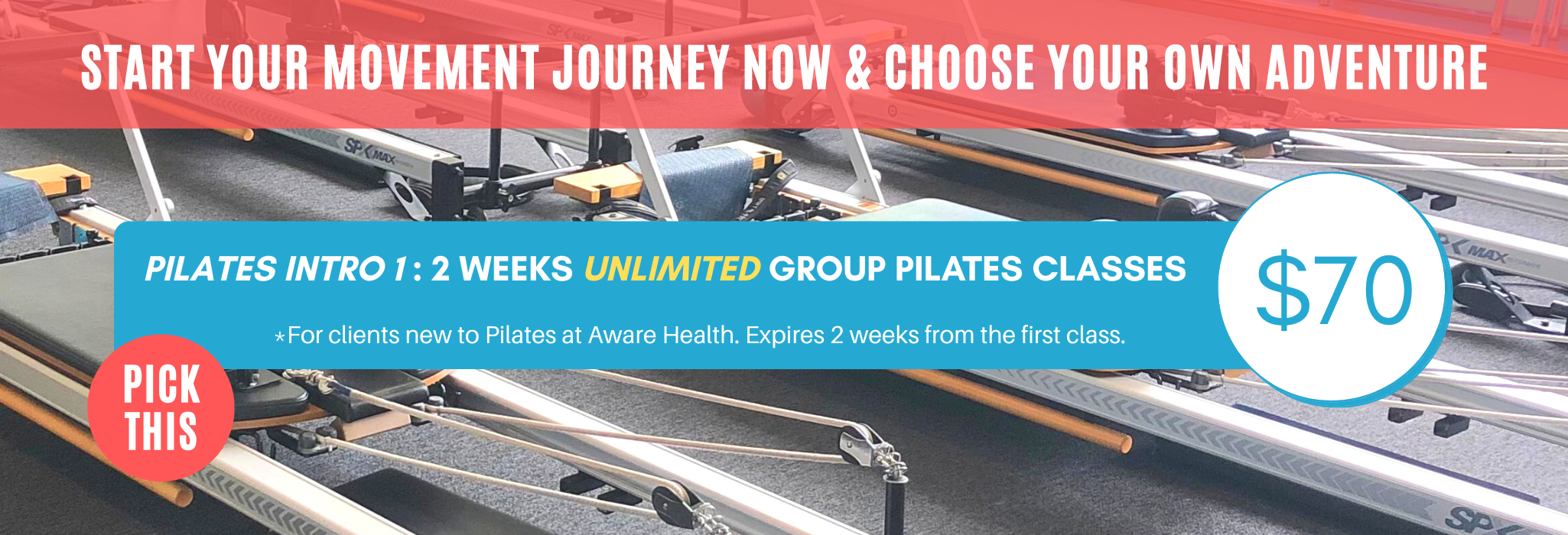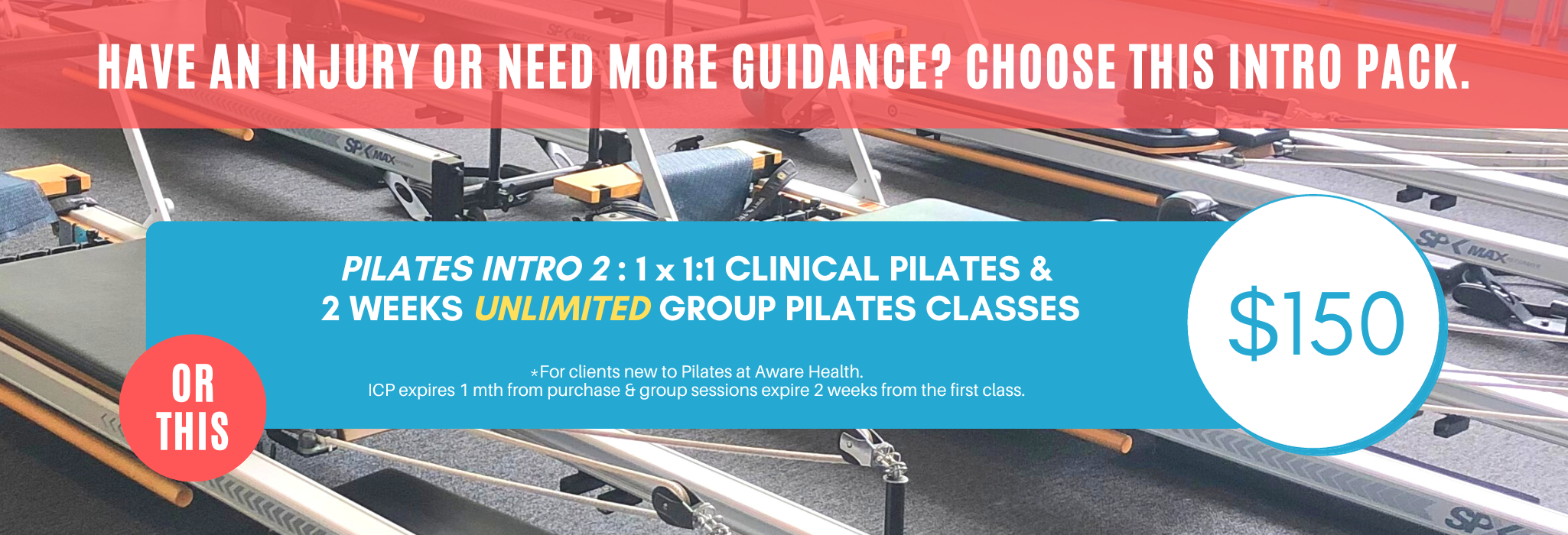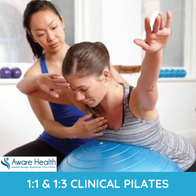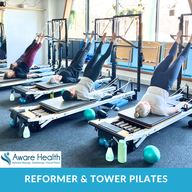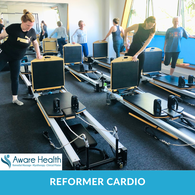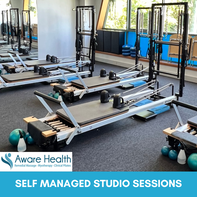WHAT IS PILATES?
Everyone who has practised pilates has heard of Joseph Pilates, who developed a physical fitness system called Contrology, taught in the early 20th century in Germany, the UK and US. Popularised by dancers in the US, Pilates as it came to be known, is a conditioning routine that improves coordination and balance, helps build flexibility, endurance and strength with emphasis on the core. Pilates is know for promoting long, lean muscles.
At Aware Health, our focus is on Stott Pilates® which is a contemporary, anatomically based Pilates training used to develop effective neuromuscular performance by focusing on core stability while balancing muscular strength with flexibility. Pilates can be performed on a mat or with specialised equipment such as the reformer, cadillac, chair and barrels, as well as smaller props including resistance bands, foam rollers, toning balls and the bosu.
Visit our FAQs page to read more about common Pilates questions.
WHAT ARE THE PRINCIPLES OF STOTT PILATES® ?
Breathing: a three-dimensional breath pattern is encourage by inhaling through the nose and exhaling through pursed lips. This technique is used to promote better oxygenation of the blood, reduces tension in the neck, shoulders and mid-back, helps to focus the mind and turn on the deep support muscles of the plumb-pelvic region.
Pelvic Placement: a neutral or imprinted pelvic position is chosen when appropriate to emphasise stabilisation of the pelvis and lumbar spine both still or during movement in all body positions. Neutral is the best position for stability and shock absorption, as well as a good place to promote efficient movement patterns. Imprint is usually used to stabilise the pelvis and lumbar spine when neutral cannot be maintained, when certain posture types require its use, or when the feet are off the floor in open chain exercises.
Rib Cage Placement: proper alignment of the rib cage in relation to the pelvis and thoracic spine are important for recruiting the abdominal muscles to encourage better breathing and spinal movements.
Scapular Movement & Stability: smooth movement and good stabilisation of the shoulder blade which lacks direct body attachment to the rib cage and spine can reduce overworking the muscles around the neck and shoulders which can lead to tension.
Head & Cervical Placement: the cervical spine (neck) should continue the line of the thoracic spine (upper back) in all movements without jamming the chin into the chest or extending the head back. Proper placement of the head and cervical spine can help to reduce neck and shoulder tension and encourage better movement.
Rather than switching each area on independently, the 5 Principles are used together to achieve better biomechanics, reduce unnecessary tension, encourage better breathing patterns, increase body awareness and aids relaxation.
Want to know how to perform the 5 principles? Click here to download the PDF.
THE PILATES STUDIO
The light filled Pilates studio is fitted with modern Stott Pilates reformers, towers and small equipment such as pilates circles, toning balls, foam rollers, resistance bands and the bosu, The studio also has a clinical height reformer with attached vertical frame (tower), enabling a more comfortable mount and dismount onto equipment (great for inflexible knees) and allowing a greater range of clinical pilates exercise modifications. Water and tea making facilities are available for you to use in the kitchenette while attending the clinic and after a satisfying workout you can cross the hall to one of our consultation rooms for your well deserved massage.
All pilates sessions will begin on time and entry to the studio will be closed 5 minutes after the start time to avoid disruptions to the classes and to ensure all health and safety procedures are adhered to. If arriving early, you are invited to relax in the studio before your pilates sessions and do some warm up stretches before classes begin, provided there are no classes running at the time. We request you use the cleaning sprays provided to wipe down any equipment after use.
We kindly ask that you turn off or switch to silent all mobile phones and take your calls outside of the clinic to avoid class disruption, and to keep noise levels to a minimum when in the hallway as massage sessions are usually in progress. We strongly advise you bring a bottle of water to rehydrate when necessary as some of our classes can be vigorous as well as mentally challenging. No food, hot drinks or glassware is allowed into the studio space to avoid damage to our equipment and other clients belongings.
WORKOUT ATTIRE
We suggest you wear comfortable workout attire that allows freedom of movement without restriction. It is important that your clothing isn't too baggy as we need to easily observe your body levels and movements to ensure the exercises are performed correctly. Pilates is usually performed without shoes and socks. If you prefer to wear socks for hygiene and comfort, we recommend you use a pair of non-slip socks with grippy soles so you that don't slip on the equipment.
|
Pilates Benefit #1
Improves posture by emphasising core stability and good alignment of all major joints during exercises. |
Pilates Benefit #2
Improves mind/body connection by focusing attention on the exercise at hand, improving spatial awareness and speeding up recovery time. |
Pilates Benefit #3
Promotes pain free functional movement by realigning the musculoskeletal system, and promoting smooth, easy range of motion. |
|
Pilates Benefit #4
Focuses on core strength but also trains the body wholistically, improving strength, flexibility and joint range of motion. |
Pilates Benefit #5
Suitable for everyone at any level of fitness, due to multitude of exercise modifications which makes it easy to tailor to individual needs. |
Pilates Benefit #6
Creates strength without the bulk by working the muscles eccentrically, resulting in a long, lean body. |

